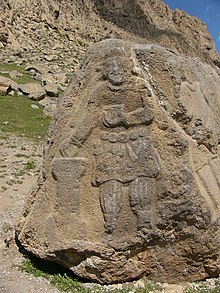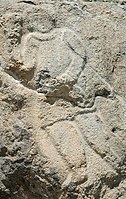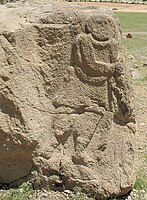Parthian Stone

Vologases's relief is a relief located in the ancient site of Bisotun in Kermanshah Province, Iran, a UNESCO world heritage site. It shows a Parthian king (possibly Vologases III)[1] with a bowl in his left hand. It also has an inscription dedicated to Vologases. This historical heritage was listed in Iranian national heritages on 10 March 2002.[2]
The inscription, written in nine lines on the surface of the altar, uses the Aramaic script to transcribe the Parthian language logographically, and reads:[3]
Vologases, King of Kings, son of (Vo)l(ogases), K(ing of Kings), grandson of P(...)
— Vologases inscription.[3]
Vologases is seen frontally, holding a bowl and sacrificing at an altar, and is flanked by two attendants carved on the sides of the rock.[3] Six kings named Vologases are known to have ruled the Parthian Empire, from 51 to the 220s CE.
-
Vologases
-
Attendant at the proper left of the King
-
Attendant at the proper right of the King
References
- ^ Olbrycht, Marek (January 2016). "The Sacral Kingship of the Early Arsacids. Fire Cult and Kingly Glory". ResearchGate. Retrieved 14 March 2018. pl:Marek Jan Olbrycht.
- ^ "Files of registration of Iranian national heritages". Archive of Cultural Heritage, Handicrafts and Tourism Organization of Iran.
- ^ a b c Hekster, Olivier; Fowler, Richard (2005). Imaginary Kings: Royal Images in the Ancient Near East, Greece and Rome. Franz Steiner Verlag. pp. 140–142. ISBN 978-3-515-08765-0.



